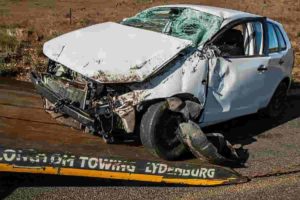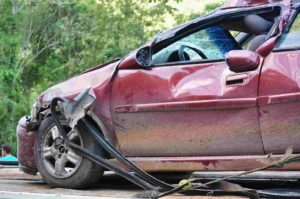No matter how safe you are behind the wheel, all it takes is one drunk, distracted, or negligent driver to cause a serious accident. If you were involved in a collision that wasn’t your fault, it’s only natural to assume that the other driver’s insurance (or your own insurance depending on your state) will cover the damages. Unfortunately, even if you played no role in causing the crash and your insurance claim is approved, you may still notice an uptick in your auto insurance premiums.
Your insurance rates are primarily based on the likelihood that you will file a claim. It might sound unfair, but having an accident on your record—regardless of who was at fault—tells the insurance company that you are a higher risk than someone with a clean driving history.
In this blog, we’ll discuss how a collision might affect your premiums, what to do after a not-at-fault accident, and how to deal with your insurer after a crash.

What Happens to My Car Insurance Premiums After a Not-at-Fault Accident?
Every car accident claim is unique, so there’s no way to predict how a collision might affect your premiums without first knowing the facts of your case. After you file the claim, your insurer will consider several factors when deciding whether to adjust your premiums. These factors include:
1. Your Driving Record
A clean driving record is the best weapon in your arsenal when it comes to getting competitive car insurance rates. If you are involved in a crash but your record is clear and the other driver is found to have been at fault, your insurance company might not increase your premiums at all. Even if your rates do increase, the uptick will be less severe if your driving record is clean.
2. Your Policy Features
Many insurers offer accident forgiveness as part of their basic policies. This “get-out-of-jail-free card” is your lifeline in the event of a crash. Bear in mind, though, that not all collisions qualify for accident forgiveness, but if you were not at fault for the wreck, it is likely that your accident forgiveness will apply if it’s part of your policy.
3. The Cost of Your Damages
Providers will consider the severity of the damage caused to your vehicle and the subsequent cost of repairs when calculating your new rates. If your claim is only for a minor scratch or small dent, chances are your insurer won’t raise your premium. But if you have to replace a shattered windshield, pricey engine parts, or your entire vehicle, it could affect your monthly rates.
4. No-Fault vs. Fault State
If you live in a “fault” state, the at-fault driver’s insurance will kick in to cover the costs of damage and injuries you sustained during the crash. In many cases, determining fault is not a clear-cut equation, so your insurance company might increase your premiums even though it doesn’t have to cover your damages.
If you live in a no-fault state, where Personal Injury Protection (PIP) or MedPay is mandatory, you would file the claim against your own insurance company rather than the insurer of the at-fault driver. As a result, you should expect your premium to rise after filing the claim.
There are only a few no-fault states in the U.S. These include:
- Pennsylvania
- New York
- New Jersey
- Michigan
- Florida
- North Dakota
- Minnesota
- Massachusetts
- Kentucky
- Kansas
- Hawaii
Typically, basic policies in these states cost more than policies in fault states, but carrying PIP or MedPay will give you peace of mind knowing that at least a portion of your damages will be covered if you are involved in a crash with an uninsured driver.

What Should I Do After a No-Fault Accident?
You had the green light, but a rushing motorist T-boned you halfway across the intersection. The radio is swallowed by a deafening thunk! as his bumper collides with your door, sending your car spinning out of control. It’s a dizzying blur of stimuli as your adrenaline surges to prepare your body for flight or fight. But you’re locked in, a seat belt saving you from crashing through the windshield, the pop of an airbag protecting your head from life-threatening contact with your dashboard and steering wheel.
A crash is a disorientating event, and in the aftermath, it can be hard to think clearly and take the right steps to recover the compensation you deserve. Read on to learn what you should do following a collision to give your claim the best chance of success:
1. Never Leave the Scene
Fleeing the scene of a car accident that has caused an injury, death, or serious property damage is a criminal offense in most states. Stay put until the police have arrived, and be sure to gather evidence before you leave.
2. Assess the Situation
Even a minor crash can result in severe injuries. Your top priority is to get medical care for yourself and anyone else who was hurt in the crash. If possible, you should move your car to the side of the road where it won’t obstruct traffic or emergency vehicles.
3. Call the Police
In most states, you are required to call the police if an accident causes physical injury, death, or serious property damage. When authorities arrive at the scene, make sure you find out how to get a copy of the police report as it will play an important role in proving negligence, liability, and damages.
4. Document Property Damage
The insurance company will want to see proof of the property damage your vehicle sustained in the crash. Be sure to take photos of damage to your vehicle, other vehicles involved in the crash, and any other property or objects that were involved in the accident.
You should also snap pictures of street signs, road markings, skidmarks, and the intersection so an accident reconstruction expert can determine how the crash occurred if there is a liability dispute.
5. Talk to Witnesses
It’s likely that other drivers or pedestrians witnessed the accident. You should talk to any eyewitnesses and take down their addresses, names, and numbers to include as part of your claim. If there is a liability dispute, their testimony may be essential for supporting your case.
6. Swap Information
Write down the names, insurance information, license plate numbers, driver’s license numbers, addresses, and contact numbers of all the drivers involved in the accident. You should also request this information from passengers.
7. Never Admit Fault
Some people are naturally inclined to admit fault after a collision, even if they played no role in causing it. Even if you believe you contributed to the accident, you should never admit fault as it could hurt your chances of recovering fair compensation.
8. Contact Your Insurance Company
Try to inform your insurer of the accident on the same day it took place. Your insurance company will explain the next steps in the claims process including the paperwork you must complete. You should provide the adjuster with an honest assessment of what happened as any fabrication could diminish your credibility and jeopardize your claim.
How Do Insurers Investigate Auto Accident Claims?
Insurance fraud costs providers billions of dollars every year in so-called “premium leakage.” For the scammers, it’s a calculated risk and a big payday. For you and other law-abiding citizens, this lost cash translates into higher premiums and more stringent insurance investigations.
Once you file the claim, your insurer will begin by reviewing records of the crash including the police report, a DMV accident report, and any evidence cataloging property damage sustained in the accident. Your provider will listen to your description of what caused the accident and where and when the accident took place. The adjuster will request any information you have gathered including the personal details of the other driver(s) involved in the collision and any other evidence that may help paint a more complete picture of what transpired.
If you live in a fault state, the insurance company will investigate your level of responsibility for causing the crash. Depending on the state where you live, your final payout may be reduced (or you might receive nothing at all) if you were partially liable for the collision. For instance, if you were rear-ended at a stop sign but your brake lights were out, the insurance company might find that you were 25% at fault for the collision. In this case (depending on your state), your payout might be reduced by 25%.
What Happens If I’m Involved in a No-Fault Accident with an Uninsured Motorist?
About 1 in 8 drivers in the United States is uninsured or underinsured. As a result, you have a high chance of being involved in an accident with a motorist who doesn’t have the coverage or finances to pay for your damages.
Although you could sue the driver, most uninsured motorists do not have the funds or assets to pay for the damages they cause in collisions. This is why it’s so important to have Uninsured Motorist Property Damage (UMPD) coverage, Uninsured Motorist Bodily Injury (UMBI) coverage, and Underinsured Motorist (UIM) coverage.
- UMPD covers vehicle damage caused by an at-fault uninsured driver in a crash. However, if you already plan on investing in collision coverage, we suggest skipping this extra as collision coverage is more comprehensive option.
- UMBI comes into play if you’re involved in a crash with an uninsured driver that causes injuries. It compensates you for medical treatment and may also cover passengers and other drivers listed on your policy.
- UIM will kick in when the at-fault driver’s insurance policy’s limits are too low to pay for your damages.
How Can I Get My Insurance Rates Reduced After a Not-at-Fault Accident?
You filed your claim, presented a solid case that you were innocent, but your insurer still hiked up your premium. Before you cancel your summer vacation, remember that there are still several ways to lower insurance rates once you’re locked into a policy:
- Scrap unnecessary coverage. If you own an older vehicle, chances are the added layer of financial protection of comprehensive or collision coverage is an unnecessary expense that will cost you more money than it saves.
- Raise your deductible. Your insurer thinks you’re more likely to get into an accident, but you know this not-at-fault crash is a statistical outlier. Increasing your deductible will reduce your premiums, but you will need to fork out more of your own money in the event of another crash.
- Transfer your policy. If your insurer won’t lower your rates, another provider may be happy to take you on as a new client. Some insurers might offer you a discount for transferring over your plan.
- Consider low-mileage insurance. If you don’t rack up significant mileage, you could net yourself access to a low-mileage discount. Ask your insurer whether they offer this lucrative cost-saving option.
- Negotiate with your insurer. If you believe the rate increase should not have happened, try negotiating with your insurance company.
